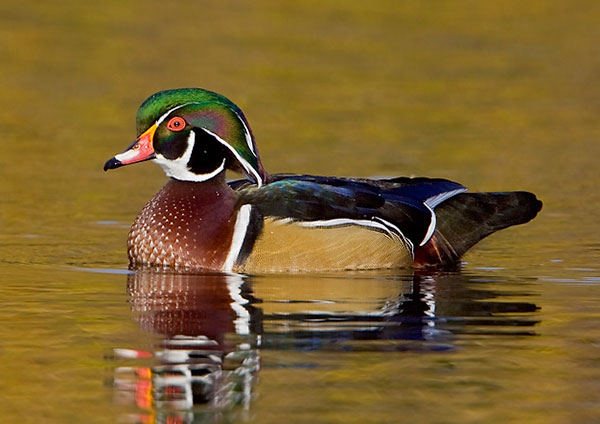With its vibrant colors, Wood Duck is a stunning perching duck species in North America.
These ducks have a long and fascinating history, from being hunted almost to extinction in the late 19th and early 20th centuries, to becoming widespread and numerous in North America today.
In this article, we will explore how to identify them, their habitat, diet, nesting habits, and much more. So grab your binoculars, and let’s take a closer look!
On this page
Identification
Wood Ducks are birds of medium to small size, with both male and female adults boasting distinctive head crests, white bellies, and white lines on the back of their wings. They have skinny necks, long bodies, thick rectangular tails, and short wings.
The adult male Wood Duck boasts a variety of colors from buffy and chestnut to iridescent green and blue. Its head is mostly iridescent green cut with white stripes. Their chest and neck are chestnut-colored, their sides bronze, their back and tail black, and their eyes red.
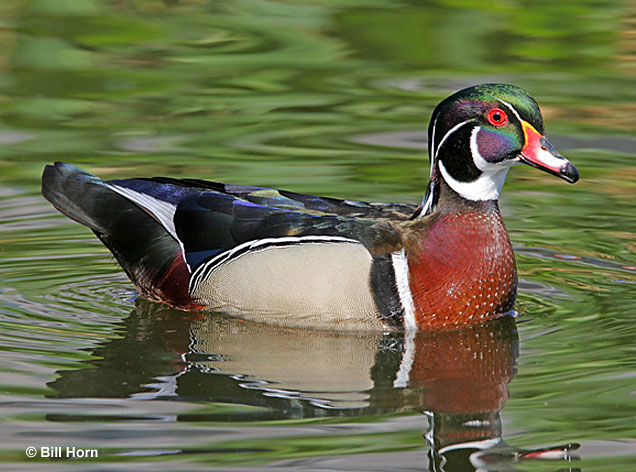
Eclipse males, aka non-breeding males, are similar to females with their grayish-brown plumage and whiter throat. They still have bright red eyes and red and white bills.
Male Wood Duck’s call is a thin whistle that rises in pitch and sounds like jeeeeee.
Female Wood Ducks are grayish-brown with white-speckled breasts. Their head doesn’t look as crested as the males’ but it’s still noticeable. They have a white teardrop-shaped area around their black eye and white along the edge of the dark blue patch in their wings. Their beak is grayish.
Female Wood Ducks have different calls to locate their mate, call their ducklings, and raise alarm. They make loud rising squeals that sound like oo-eek, oo-eek when taking flight or being disturbed, and sharp cr-r-ek sounds when raising alarm.
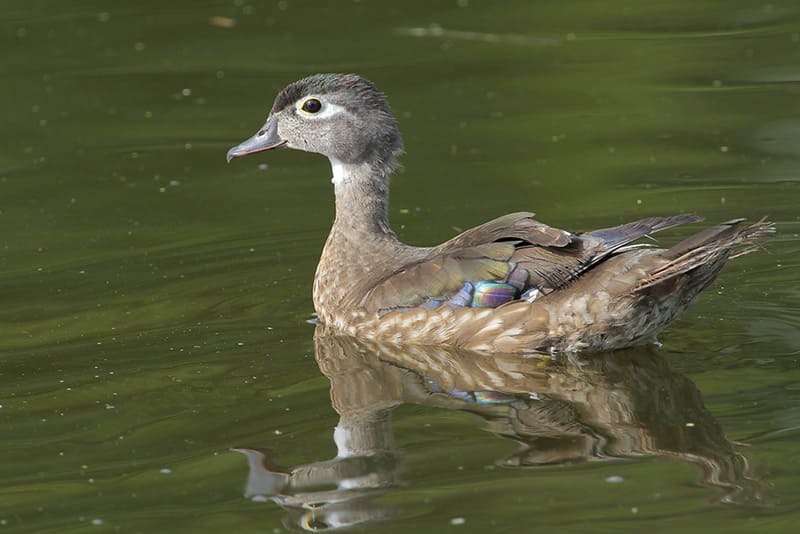
Female Wood Duck
Food
Wood Ducks are omnivores, with 80% of their diet consisting of different plant matter. They eat insects and other arthropods but also seeds, grains, nuts, fruit, and aquatic plants.
You can see them foraging in the water by taking food from the surface or submerging their head and neck. Sometimes they also up-end, meaning that you can only see their rear poking out of the water. They may also walk on dry land to forage for acorns, nuts, or grain.
Their diet includes seeds and nuts, such as acorns, maples seeds, and hickory nuts; berries and fruit, such as blackberries and wild cherries; different plants, such as panic grass, duckweed, waterlily, and primrose; and different insects and small aquatic creatures, such as flies, beetles, isopods, snails, caterpillars, dragonflies, slugs, moths, etc.
Young ducks mostly eat insects and other invertebrates.
Nesting and Eggs
Wood Ducks are serially monogamous. The male stays with one female for one breeding season. The pair looks for a nest site together, however, after mating, the males separate from the females and flock together to molt.
Wood Ducks choose to build their nests close to water, utilizing tree cavities that can range from 2 to 60 feet off the ground. The higher the nest is, the more secure it is from potential predators. These birds cannot make their own cavities and instead use ones formed from fallen branches and natural decay.
Artificial nest boxes can also serve as suitable nesting sites for them. The interior of the cavity is filled with a cozy mixture of wood chips and feathers plucked from the female’s breast.
Nest cavities can have openings as small as 4 inches, which makes it difficult for predators to access, but Wood Ducks may also opt for larger openings of up to a couple of feet. The depths of these cavities can vary, with the average being 2 feet, but in rotten trees, they can reach as deep as 15 feet.
Females lay between 6 to 15 white to tan eggs that are 1.8-2.4 inches long and 1.4-1.6 inches wide.
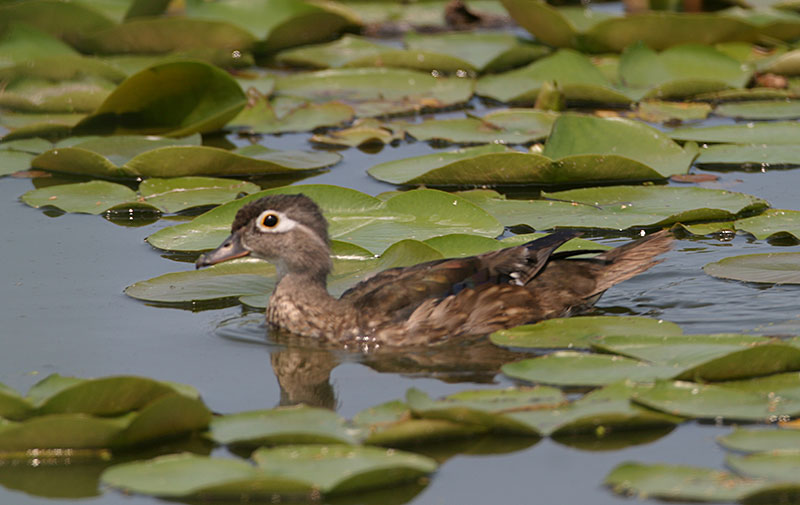
Young Wood Duck
Sometimes even more are found in a nest due to a behavior called egg-dumping, where other females lay their eggs in other nests. At this point, the female is on her own and incubates the eggs for 25-35 days, with the chicks leaving the nest just a day after hatching.
The young reach independence in 56-70 days.
Current Situation
Wood Ducks can be found throughout North America, ranging from Nova Scotia in the east to the center of the United States, and from British Columbia to the Mexican border on the west coast.
During the winter, the Wood Ducks in the eastern part of the range migrate southeast, while those on the western coast winter in southern California and along the Mexican Pacific coast. The southern Wood Ducks do not migrate, and some females may even be permanent residents.
Wood Duck’s habitats include lakeside forests, rivers, streams, wetlands, swamps, and different ponds. For successful breeding, the nesting sites have to be within a one-mile radius of water.
During winter, their habitats mirror those used during the breeding season. They prefer areas that offer a balance of open water and vegetative cover, which provides them a place to hide and forage.
Despite habitat destruction and hunting in the early nineteen hundreds where they almost went extinct, Wood Ducks bounced back and are now listed as a species of low concern in the IUCN Red List. Their population is around 4,6 million and increasing.
Facts
- Wood Ducks are known under many different names, such as Carolina ducks, woodies, acorn ducks, swamp ducks, summer ducks, and squealer ducks.
- Wood Ducks have sharp claws on their feet, enabling them to climb and perch with ease. This adaptation sets them apart from other ducks since there are only a few other species of ducks with claws strong enough to climb trees.
- Wood Ducks can and may interbreed with other duck species, such as Mallards. However, the offspring is often infertile.
- Wood Ducks are capable of staying underwater for at least a minute.
- Wood Ducks are the only ducks in North America capable of having two broods in one season.
Similar Species
Wood Ducks are quite unique, but there are still three similar species that may have you make a double-take. Read on to learn how to differentiate between them.
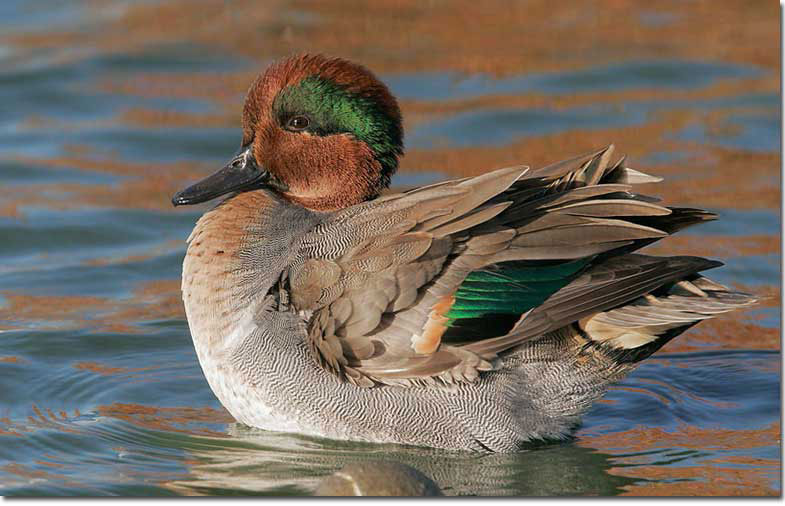
Green-winged Teal
Green-winged Teal
Male Green-winged Teals have quite similar color patterns, but the teal is a bit more modest and light-colored.
Green-winged Teal doesn’t have the distinctive head crest, they have black eyes instead of red, and they are more uniformly gray and light brownish overall.
Female Wood Ducks and female Green-Winged Teals look quite similar as well, however, Green-Winged Teals are smaller, have a rounder head, and lack the crest and white eye ring the female Wood Duck has.
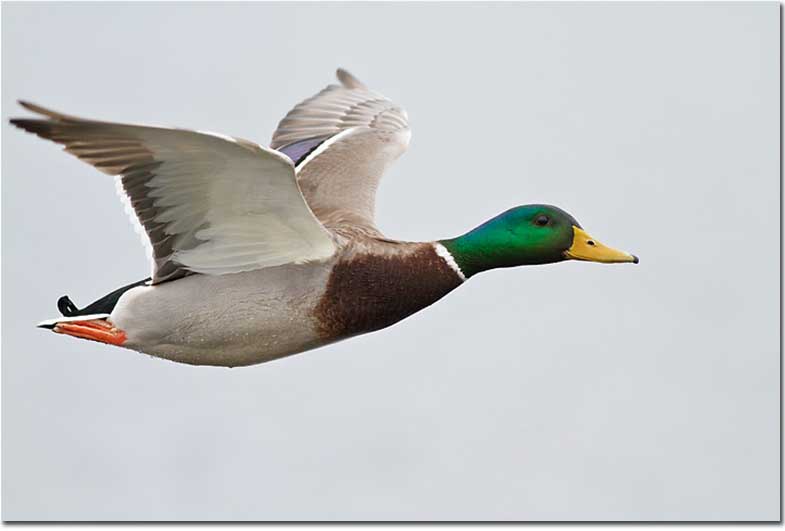
Mallard
Mallard
Male Mallards have an all-green head and gray body, yellow beak, and black eyes.
They don’t have a head crest. The females of the two species are much more similar, even having the same dark blue speculum.
However, female Mallards lack the head crest and white ring around their eyes. They also look “scalier” with their markings, whereas a female Wood Duck is more uniformly colored.
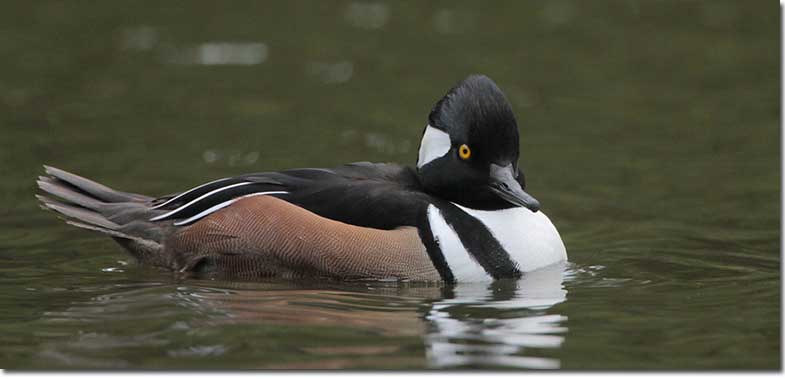
Male Hooded Merganser
Hooded Merganser
Hooded Mergansers also have an impressive crest; however, their head coloring is different.
Their head and crest are black and white, their eyes are yellow and they have white breasts.
Their beak is longer, thinner, and black instead of orange and white.
Female Hooded Mergansers have a more impressive crest than female Wood Ducks. Female Hooded Mergansers have yellow eyes and longer and thinner black beaks instead of black eyes and shorter grayish beaks. They also lack the white eye ring.
Frequently Asked Questions
Why is a Wood Duck called a Wood Duck?
Wood Duck got its name for the fact that it nests in tree cavities and likes to perch on trees.
What is special about a Wood Duck?
Wood Ducks are quite unique since they nest in tree cavities and are able to climb trees using their feet.
Is a Wood Duck a Mallard?
A Wood Duck and a Mallard are two different species with similarities in appearance.
Where do Wood Ducks live?
Wood Ducks prefer to live in forests, swamps, freshwater marshes, near streams, and ponds that have a balance between open water and vegetative cover. They nest in tree cavities.
Do Wood Ducks migrate?
Wood Ducks inhabiting the northern areas of the United States are migratory. Female Wood Ducks in the south may be permanent residents.

